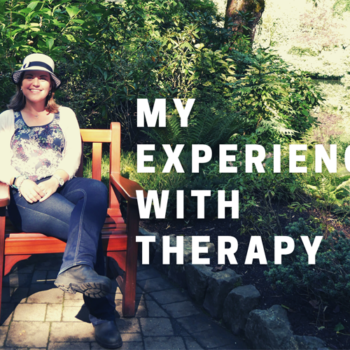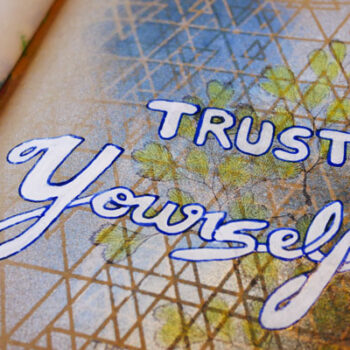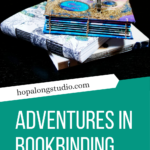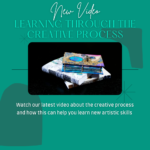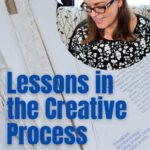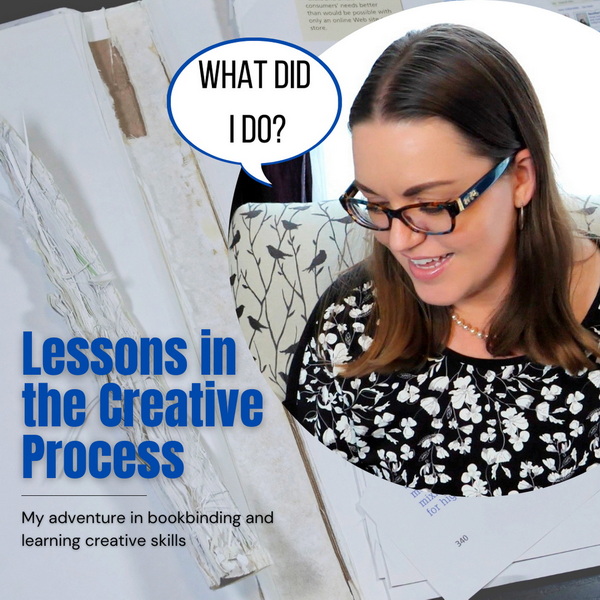
Lessons in the Creative Process: My Adventure with Book Binding
Do you ever want to learn a new art skill or technique but don’t know where to start? I had that experience this last weekend. I wanted to learn how to rebind a used book and add new paper and I wasn’t sure how to go about it. Today I will be sharing with you lessons in the creative process and some of the things I learned through my adventures in book binding.
I’ve been dabbling with book binding on and off over the last couple years. Once or twice a year I’ll play around with book binding but with very mixed success. The books I have made up to this point are simple and don’t require glue or exotic materials.
I’m taking several mixed media classes this weekend and decided that I would learn how to repurpose old books for these classes. This was intimidating for me because it would require several things:
1. Learning how to take a book apart without ruining the cover
2. Learning how to make a book block using glue (intimidating!)
3. Learning how to put the book back together
When I’m intimidated by something I usually find a local artist to learn the skill in person. In this case I was on my own. I would have to jump into the creative process and learn this skill by trial and error.
Just Starting
When you are learning something for the first time, the hardest part is just starting. I had previously purchased a few books from my local thrift store to use for these projects. I had a week to get these books done before the class, so I had to start early if I wanted to finish them on time. Having deadline pressure is often the push to get me started.
It can be hard to know where to start. When it came to disassembling a book, it was choosing a spot to gently cut and figure out how to separate the book cover from the book block. It was both harder and easier than I thought! I had such a mess of paper and paper pieces, but what I learned was not to be too careful about manhandling the book. If I messed up, the book was only a few dollars at the thrift store and couple be easily replaced. But learning how to take apart the book was a valuable skill.
Even though we might not have all the information, we can let ourselves experiment, to embrace the creative process, and this is where we learn.
Making Mistakes
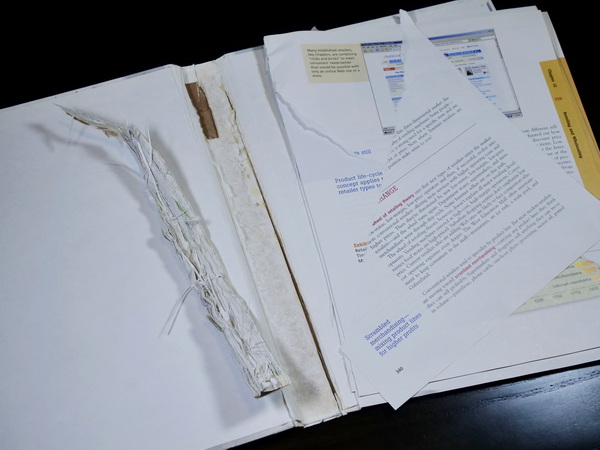
The first book that I took apart was not difficult to disassemble. I was able to get the text block off easily and was so pleased that it wasn’t as much work as I feared. The second book I tried to disassemble was a textbook and I was surprised how hard it was to take apart. I had forgotten that most textbooks are bound tighter as they are made for abuse and rough handling.
The mess in my little studio was ridiculous. Not only was there paper everywhere, but it was also hard to get the book block to come loose from the spine. I got a bit impatient and ended up being a bit too rough. I cut through the spine in a couple of places.
Making mistakes when you work on projects is part of the creative process. Cutting through the spine was not ideal, but as I planned to alter the book the mistake would be covered up. It is important that we don’t let our mistake detract from the lessons we can learn through the process. What I learned is to choose my books more carefully and be a bit gentler when disassembling a book.
Adding to Your Current Knowledge
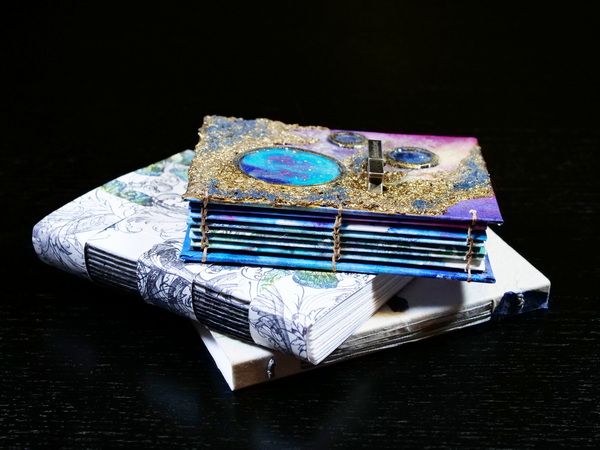
When learning new skills, I try to springboard off my current knowledge. In this case, I had made a few simple handmade books before. I knew how to fold signatures and do basic book sewing. It’s important to remind ourselves of what we do know because this can prevent us from getting overwhelmed about the things we don’t know.
Creating Requires Risk
I knew that repurposing these books would be much more complicated than my previous books. The previous books were small books made with thin paper that was easy to fold and sew.
This book was going to be a completely different animal. I was going to use high quality watercolor and Bristol paper in this book. The paper was thicker, harder to fold and was more challenging to create into a book. It felt like more of a risk because what if I ruined it? Even though I had a basic knowledge on how to make the signatures and create the paper block, what if I put all this time and nice materials into it and it was a flop? The inner critic was running wild. Perfectionism was staring me in the face telling me not to try, because I might fail.
Try Anyways
So what to do with these feelings? Try anyways. I figured out what the cost to me would be if I made a mess of it. It would meant taking a few hours re-cutting paper. I would be out a few sheets of high-quality paper. I would have to go find a new book to repurpose. That would be the total outcome of failure.
But what would the positive results be if it worked out? I would have repurposed a book, learned to create a signature block and it would be an awesome experience. More than that, I would have a great book to create in for the coming months. It would be my own repurposed book with my favorite art paper inside. I would have a book that I was proud of, and I would have learned a bunch of new skills through the trial and error of embracing the creative process.
Learning from Others
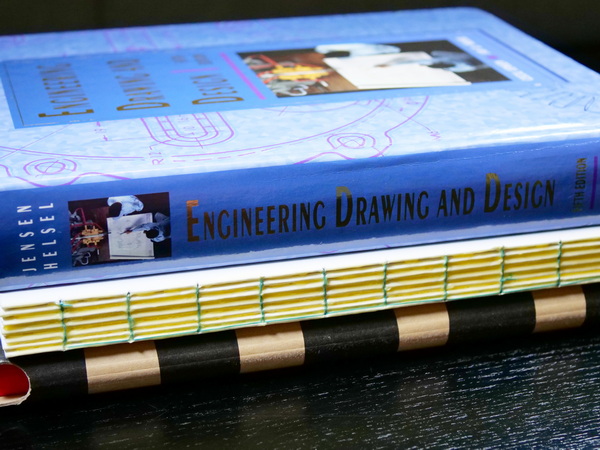
After I had folded and grouped my pages into signatures, I realized that I would need to sew them together, add glue and eventually add a lot more glue to finish this book. This is where I started feeling a bit over my head. All I could think about was glue getting everywhere and gluing all my pages together.
This is where learning from others comes into play. I have a book about book binding. While I find the projects inspiring, sometimes the instructions aren’t very clear. As an alternative, I jumped on YouTube to see what other help I could find. After a few searches I found some amazing resources from @sealemon. I’ve been following her for a while now, but she had the perfect videos to help me through the creative process of making a handmade book. I was so inspired!
My book blocks are now glued in place, and I couldn’t be happier with the result! For something that I was so intimidated by, it really was quite simple. I used a brush and a palette to manage my glue and ended up with great results.
What’s Next
At this point I haven’t finished my project due to drying time. I still have some more gluing and drying to do before my books are finished. But my intent is to share my experience with you as I journey through the creative process.
We can get so bogged down in the steps, having the right materials, or having everything figured out that we can miss the lessons in the process. Sometimes the process and what we learn about ourselves in this creative process is more important that the finished project.
We need to remember to be kind to ourselves. When we are learning new skills, it’s not going to come automatically. Learning art is like learning an instrument or how to drive a car. It can take hundreds or thousands of hours to be proficient. But we need to start somewhere.
More than anything, I want to encourage you to try. Try book binding, try painting, try mixed media. You don’t know what you can achieve unless you try. It’s good watch videos on YouTube, but at some point to learn the skills, you need to pick up your art tools and create something.
Come Say Hello!
I hope that this has provided you some encouragement. If it has, I would love for you to say hello! You can leave your comments below or contact me directly. I would love to hear from you! I hope that you take time to create this weekend and learn something new about yourself through the creative process.




